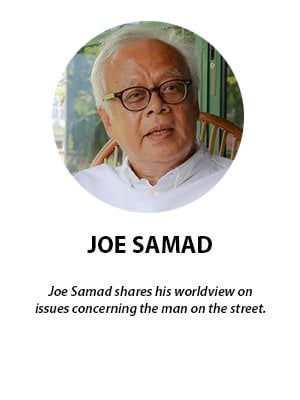
In its 2020 Yearbook, based on a 2010 census, the state’s total population was categorised by ethnicity – Kadazan/Dusun, Bajau, Murut, Bumiputera lain, Cina, India and “lain-lain” (others).
The latest 2021 report, however, has removed the specific ethnic categories and instead lumped them up under ‘Bumiputera lain’ while maintaining the “Cina”, “India” and “lain-lain” categories.
In 2015, a controversy raged when the Borneo states discovered that the government had removed all East Malaysian ethnicities and lumped everyone under the derogatory term “lain-lain”.
The controversial term was removed after strong protest from the Sabah and Sarawak state governments which eventually saw the people of both Borneo states being allowed to state their ethnicity on government forms.
While the new “Bumiputera lain” category may be for statistical convenience, questions inevitably arise as to its intent and purpose.
The new categorisation appears to support former prime minister Dr Mahathir Mohamad’s deluded theory about “constitutional Malays”.
It will see Malaysia – at least on paper – moving towards creating a more homogenous society, at least on paper, with “constitutional Malays” as the dominant race, while the ethnic identities of other Malaysians are seemingly erased.
The Borneo states do not have the “3R” issue. We do not even have the “R” which stands for royalty. Here, everyone is equal.
The 2010 census said Sabah had 184,197 “Melayu”, which rose to 236,934 in 2020. That is a huge increase. Who are these Melayu? The closest we get to Melayu in Sabah are the Brunei Malays.
The 2020 census figure for “Bumiputera lain” was 2,076,537 versus 659,865 in 2010. Those figures are difficult to compare at a glance as the demographic categories have changed.
The other difficulty in ascertaining the true population of Sabah is the existence of a large non-documented and transient population.
In 2010, the combined population of Sabahans of Kadazan/Dusun, Bajau and Murut descent was 1,121,247, while “Bumiputera lain” numbered 659,865, giving a total of 1,781,112 for both categories. However, in 2020, a single category – “Bumiputera lain” – showed a figure of 2,076, 537, a marked increase of 295,425 persons.
Dr Chong Eng Leong, an expert on the illegal and undocumented population, to whom I spoke, deduced that the increased figure may be the result of the government masking the Project IC population figures and marrying it with the Sabah ethnic majority.
He worries that a mere acceptance of the new categorisation will result in a loss of identity for the affected ethnic groups.
In 2012, a royal commission of inquiry was held on the illegal population of Sabah. One of the controversies involved the issuance of blue ICs to members of the state’s undocumented population, also known as “Project IC”.
Accused of doing it for political convenience, Mahathir later claimed it was the right move as these illegals have lived in Malaysia for many years.
Project IC saw an unprecedented increase in Sabah’s population which could only be explained by the act of legalising illegals and undocumented persons.
In December 2014, then opposition leader Anwar Ibrahim said the findings of a 2012 Royal Commission of Inquiry (RCI) investigating the abnormal spike in Sabah’s foreign population was not only “farcical” but had also failed to bring the real culprits behind the problem to book.
Anwar noted that the RCI had placed the blame squarely on errant civil service runners for what he described as the “biggest illegal immigrant scandal” in Malaysian history since independence.
The 2021 Yearbook puts Sabah’s total population as at 3,412,600 million, of which 2,633,200 million are citizens and 779,500 non-citizens.
Again, who are these non-citizens? Even Peninsular Malaysians need work permits to live in Sabah, or, if they are married to Sabahans, require a spouse permit to reside in the state.
Anwar said the 366-page report contained “meaningless” texts that saw all government agencies and departments completely exonerated of any culpability in the scandal, which has now resulted in nearly 30 per cent of Sabah’s 3.12 million population being made up of foreigners.
Now, as prime minister, he has the chance to rectify the situation.
Recently education minister Fadhlina Sidek announced that the government will be amending existing legislation to allow undocumented children, non-citizens and those whose citizenship status is being processed into public and government-funded schools.
If this happens, the rightful citizens of Sabah will be deprived of adequate education infrastructure unless funding is increased.
Already, the education ministry has identified 289 dilapidated schools in Sabah, with 64 deemed unsafe by the Public Works Department (PWD).
Fadhlina said these 64 schools scored “7” on the impact grade (a score that considers buildings to be in the worst shape), while 225 schools rated “6”.
Buildings rated “1” to” 4” on the scale are still functioning, safe for use, and need only periodic maintenance, while buildings rated “5” are deemed unsafe and needing maintenance.
The dramatic increase in the state’s population also means that without additional funding for health and infrastructure, Sabahans will be deprived of the quality of life they deserve. - FMT
The views expressed are those of the writer and do not necessarily reflect those of MMKtT.


No comments:
Post a Comment
Note: Only a member of this blog may post a comment.